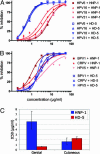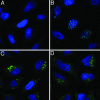Human alpha-defensins block papillomavirus infection
- PMID: 16432216
- PMCID: PMC1360544
- DOI: 10.1073/pnas.0508033103
Human alpha-defensins block papillomavirus infection
Abstract
Sexually transmitted human papillomaviruses (HPVs) are the primary cause of cervical cancer. Recent advances in techniques for production of papillomaviral vectors [known as pseudoviruses (PsVs)] have made it possible to perform high-throughput screens for compounds that might block the initial stages of papillomavirus infection. We have used PsVs to screen a variety of compounds that might function as inhibitors of HPV infection, with emphasis on human peptides previously implicated in innate antimicrobial immunity. Little is known about the possible activity of these peptides against nonenveloped viruses, such as HPVs. Our screen revealed that human alpha-defensins 1-3 [known as human neutrophil peptides (HNPs) 1-3] and human alpha-defensin 5 (HD-5) are potent antagonists of infection by both cutaneous and mucosal papillomavirus types. In contrast, human beta-defensins 1 and 2 displayed little or no anti-HPV activity. HD-5 was particularly active against sexually transmitted HPV types, with 50% inhibitory doses in the high ng/ml range. Microscopic studies of PsV inhibition by the alpha-defensins revealed that they block virion escape from endocytic vesicles but not virion binding or internalization. Consistent with this finding, PsVs remained susceptible to inhibition by alpha-defensins for many hours after initial binding to cells. HNPs 1-3 and HD-5 have been reported to be present in the female genital tract at levels that overlap those that inhibit HPVs in vitro, suggesting that they could present a natural barrier to the sexual transmission of HPV and could serve as the basis of a broad-spectrum topical microbicide.
Figures



References
-
- Janeway, C. A., Jr., & Medzhitov, R. (2002) Annu. Rev. Immunol. 20, 197-216. - PubMed
-
- Platanias, L. C. (2005) Nat. Rev. Immunol. 5, 375-386. - PubMed
-
- Braff, M. H., Bardan, A., Nizet, V. & Gallo, R. L. (2005) J. Invest. Dermatol. 125, 9-13. - PubMed
-
- Selsted, M. E. & Ouellette, A. J. (2005) Nat. Immunol. 6, 551-557. - PubMed
-
- Schiffman, M. & Kjaer, S. K. (2003) J. Natl. Cancer Inst. Monogr. 14-9. - PubMed
Publication types
MeSH terms
Substances
Associated data
- Actions
Grants and funding
LinkOut - more resources
Full Text Sources
Other Literature Sources

